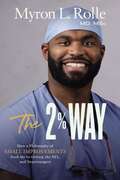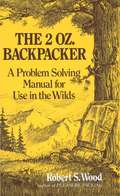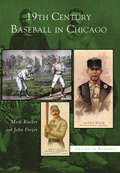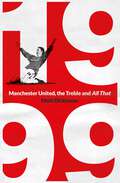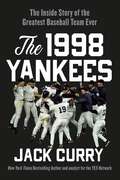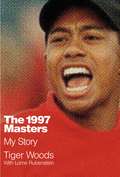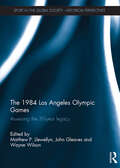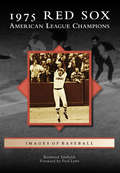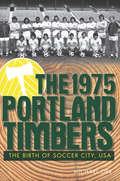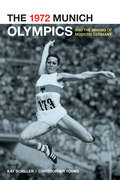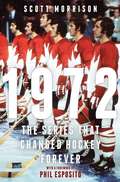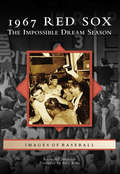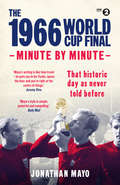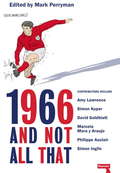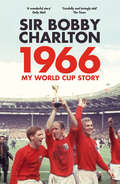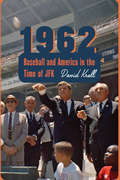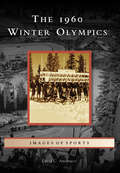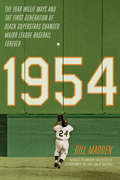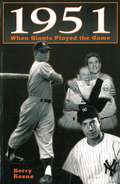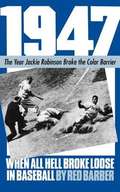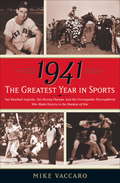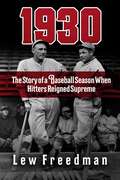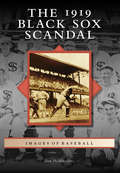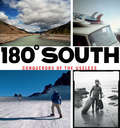- Table View
- List View
The 2% Way: How a Philosophy of Small Improvements Took Me to Oxford, the NFL, and Neurosurgery
by Dr. Myron L. RolleYou don't have to change your life overnight--instead, you can make small changes that leave a lasting impact. In The 2% Way, discover the simple, revolutionary practice behind the against-the-odds success story of Dr. Myron L. Rolle.Dr. Rolle has led a remarkable life: from earning a scholarship to a prestigious private high school to becoming a top-rated recruit at Florida State University; from winning the Rhodes Scholarship for study at Oxford to playing football in the NFL and then becoming a neurosurgery resident at Harvard.In this inspiring book, Dr. Rolle tells the story of his incredible journey, revealing how a strong work ethic, deep faith, and the family values instilled by his Bahamian immigrant parents set the stage for the transformative life philosophy that enabled him to overcome adversity, defy expectations, and create a life of meaning and purpose.Whether you're struggling with your own obstacles, looking to improve yourself, searching for your purpose and identity, or seeking inspiration, Dr. Rolle's story will give you the encouragement and tools you need to:Make incremental improvements that lead to long-lasting resultsBuild a life full of purpose and meaningTackle life with the assurance that you're moving in the right directionThe 2% Way will change the way you think about self-improvement, proving that you have the power to make strides toward the life you've always dreamed of.
The 2 Oz. Backpacker: A Problem Solving Manual for Use in the Wilds
by Robert S. WoodThis featherweight little book will keep you out of trouble in the wilds by helping you make decisions like a veteran wilderness traveler. It will help you get the most from the food and gear you carry on your back, making your trip safer, more comfortable and, above all, more fun.HOW TO...make quick repairs to packs, boots, tents, beds and stoves...choose and develop a campsite for maximum comfort and shelter...deal with emergencies, storms and other difficulties...treat blisters, hypothermia, sunburn, bleeding, elevation sickness, etc... keep snug, dry, comfortable and warm in heavy weather.PLUS TIPS ON fire building, cooking, water treatment, getting found when lost, hiking, climbing, cross-country and route-finding techniques.From the Trade Paperback edition.
19th Century Baseball in Chicago (Images of Baseball)
by Mark Rucker John FreyerThe Chicago area today hosts two of the most historic major league franchises and half a dozen minor or independent league teams. Baseball's roots run deep in the Windy City. Indeed, it was Chicago businessman William "I'd rather be a lamp-post in Chicago than a millionaire in any other city" Hulbert, who, according to baseball lore, staged the coup that in 1876 would put the National League on the map. The Chicago White Stockings (now ironically called the Cubs) were one of eight charter members, winning the inaugural NL Championship with such legendary names as A.G. Spalding, "Cap" Anson, and Roscoe Barnes.But The National Pastime arrived in Chicago well before the 1876 season, as is proven in this fascinating new book, 19th Century Baseball in Chicago, illustrated with over 150 vintage images.Any local fan of the modern game-whether the action takes place at the "Friendly Confines," 35th & Shields, or the cozy setting of a minor league ballpark out in Kane or suburban Cook County-will enjoy the wealth of information offered in 19th Century Baseball in Chicago.
1999: Manchester United, the Treble and All That
by Matt DickinsonIn 1999, Manchester United completed a unique Treble, winning the Premier League, FA Cup and Champions League - but more remarkable than that was how they did it, and the stories behind the historic achievement. Matt Dickinson covered the whole story at the time, and now in 99 compelling chapters brings it all vividly to life.When the season began, Manchester United were up for sale, the club's iconic talisman Eric Cantona had gone, rivals Arsenal were the reigning Double winners, David Beckham was a national hate figure after being sent off during the World Cup, and even manager Alex Ferguson's position was being questioned. Early signs weren't promising, despite record spending to bring in new stars, among them Jaap Stam and Dwight Yorke, but soon things began to change.Driven by the indomitable will of skipper Roy Keane, supported by a nucleus from the Class of 92 - Beckham, Nicky Butt, Ryan Giggs, the Nevilles and Paul Scholes - who had grown up at the club, they went on a long unbeaten and unbeatable run, featuring some of the most dramatic games in fans' memories. Matt Dickinson highlights the key moments, speaking to those at the centre of the story and to those whose moment went unnoticed. 1999: Manchester United, the Treble and All That is so much more than a book for United fans; it is an insight into team building, the will to success and a tale of local pride. It reveals the real stories behind the legend that was sealed with a last-minute scrambled goal from Ole Gunnar Solskjaer to win the Champions League.
The 1998 Yankees: The Inside Story of the Greatest Baseball Team Ever
by Jack Curry"The 1998 Yankees were a perfectly constructed team. Jack Curry does an amazing job of telling the tales of that phenomenal group." —David ConeDiscover the inside story of the Yankees' unprecedented talent with this gripping account from a reporter who was there for the team's 125 wins. The visiting clubhouse in San Diego was soggy, sweaty and sticky after the 1998 Yankees swept the Padres in four games and celebrated winning their 24th World Series title. The players raised bottles of Champagne, sprayed the bubbly on each other and reveled in a baseball season that might have been more memorable than any in history. Jack Curry was part of that unforgettable scene as a reporter, navigating around the clubhouse to ask the same, pertinent question. After winning an unprecedented 125 games and pummeling teams along the way, were these Yankees, the Yankees of Jeter, Mariano, Posada, Pettitte, Bernie, O&’Neill, Tino and so many other vital players, the best team ever? &“Right now, you would have to call them the best team ever,&” said owner George Steinbrenner. Twenty five years later, Curry revisits that season to discuss how that team was built and why the Yankees were such a talented, refreshing and successful club. This book includes new interviews with more than 25 players, coaches and executives, who revealed some behind-the-stories about the magical journey and who also discussed the depth of this historic squad. &“From the first man to the 25th man on the roster, I don&’t think there&’s a team that had more talent and a team whose players knew their roles as well as our players did,&” said pitcher David Cone. &“If you&’re using that as a barometer for the best team of all-time, then I think you can call us the best team of all-time.&” During that wondrous season, Don Zimmer, a Yankee coach and a baseball lifer who began his career with the Brooklyn Dodgers in 1954, told associates there would never be another team like the 1998 Yankees. Zimmer was right. Twenty five years later, Curry describes how and why that Yankee team could be the best ever.
The 1997 Masters: My Story
by Lorne Rubenstein Tiger WoodsTo mark the twentieth anniversary of his historic win at the 1997 Masters, Tiger Woods will for the first time reflect on the record-setting win both on and off the course.In 1997, Tiger Woods was already among the most-watched and closely examined athletes in history. But it wasn't until the Masters Tournament that his career would definitively change forever. Woods, then only 21, won the Masters by a historic 12 shots, which remains the widest margin of victory in the tournament's history, making it an iconic moment for him and sports.Now, 20 years later, Woods is ready to explore his history with the game, how it has changed over the years, and what it was like winning such an important event. With never-before-heard stories, this book will provide keen insight from one of the game's all-time greats.
The 1984 Los Angeles Olympic Games: Assessing the 30-Year Legacy (Sport in the Global Society - Historical Perspectives)
by Matthew P. Llewellyn, John Gleaves and Wayne WilsonThe 1984 Los Angeles Olympic Games stand as the most profitable and arguably the most important event in the history of the modern Olympic movement. Fresh off the back of the financially disastrous Montreal Games of 1976 and the politically controversial Moscow Games of 1980, the Olympic movement returned to the United States for the sixth time in an attempt to salvage the economic viability and global prestige of the Olympics. The Los Angeles Olympics proved to be both provocative and polarizing. On the one hand they have been heralded as an overwhelming, transformative success, ushering the Olympic movement into the modern commercial age. On the other hand, critics have repudiated the Games as a manifestation of commercial excess and a platform for western political and cultural propaganda. In conjunction with the 30th anniversary of the Los Angeles Olympics, this volume examines their legacy. With an international collection of contributing scholars, this volume will span a range of global legacies, including the increasing commercialization of the Games, the changing participation of women, the Communist boycott movement, nationalism and sporting identity, and the modernization and California-cation of the Games. This book was originally published as a special issue of the International Journal of the History of Sport.
1975 Red Sox: American League Champions (Images of Baseball)
by Raymond Sinibaldi Fred LynnThe 1975 American League Champion Boston Red Sox squared off with the Cincinnati Reds in what is widely recognized as one of the best World Series ever played. The Major League Baseball Network has named its sixth game "the greatest game ever played." The Red Sox were led by two rookies, 21-year-old Jim Rice and 22-year-old Fred Lynn, who formed a rookie duo the likes of which baseball had never seen. They combined with a budding superstar in Carlton Fisk and his aging counterpart Carl Yastrzemski to lead the Red Sox attack, while a wily Luis Tiant anchored the pitching staff. After a first-round sweep of the three-time World Champion Oakland A's, they advanced to a Fall Classic that echoes through the ages, and in the words of Carlton Fisk, the Red Sox won "three games to four.
The 1975 Portland Timbers: The Birth of Soccer City, USA (Sports)
by Michael OrrRelive the magic of the Portland Timbers' 1975 season and the birth of Soccer City, USA. This is the story of seventeen players and two coaches who came from different clubs and different countries to form a team just days before their inaugural game. In this fast-paced account, Michael Orr weaves together player interviews, news coverage, and game statistics to capture the Timbers' single-season journey from expansion team to championship contender. From the first televised game against Pele's New York Cosmos to the seven-game winning streak that vied for a league record and the post-season battle for the game's highest prize, rediscover how, in just four months, the Timbers won the hearts of Portlanders and left an indelible stamp on the Rose City's sporting landscape.
The 1972 Munich Olympics and the Making of Modern Germany
by Christopher Young Kay SchillerThe 1972 Munich Olympics-remembered almost exclusively for the devastating terrorist attack on the Israeli team-were intended to showcase the New Germany and replace lingering memories of the Third Reich. That hope was all but obliterated in the early hours of September 5, when gun-wielding Palestinians murdered 11 members of the Israeli team. In the first cultural and political history of the Munich Olympics, Kay Schiller and Christopher Young set these Games into both the context of 1972 and the history of the modern Olympiad. Delving into newly available documents, Schiller and Young chronicle the impact of the Munich Games on West German society and deliver the first full account of one of the most significant moments in post-war German history.
1972: The Series That Changed Hockey Forever
by Scott MorrisonThe legacy of the greatest hockey series ever played, fifty years later, with stories from the players that shed new light on those incredible games and times.&“Cournoyer has it on that wing. Here&’s a shot. Henderson made a wild stab for it and fell. Here&’s another shot. Right in front...they score! Henderson has scored for Canada!&” These immortal words, spoken to hockey fans around the world by the legendary broadcaster Foster Hewitt, capture the historic final-seconds goal scored by Paul Henderson that won the 1972 Summit Series against the Soviet Union. Hockey fans know the moment well, but the story of those amazing eight games has never been fully told—until now. The series was the first of its kind, and one of the most dramatic sporting showdowns in history. With the Soviets dominating international hockey, this series was meant to settle the debate, once and for all, of who owned the game. It was Canada&’s best against the Soviets for the first time. And in the shadow of the Cold War, this was about more than eight games of hockey. Expectations were high as the series began. This was supposed to be easy for Team Canada, but after the disappointing first four games on home ice with only one win, victory seemed out of reach. With the final four games in Moscow, Canada got a rare glimpse behind the iron curtain as the team, as well as three thousand raucous fans, arrived in the USSR. Amid the culture shock and strained relations, what followed was a tug-of-war battle that lasted to the dying seconds of game 8. Now, five decades after this historic event, it&’s time to reflect on the greatest hockey series ever played. Veteran journalist and hockey analyst Scott Morrison uses a storyteller&’s voice to reveal what it meant to hockey then, and what it means now. Filled with the memories of the players and others involved with the series, he shows how it changed the game, and challenged a nation&’s sense of identity and place in the world.
1967 Red Sox: The Impossible Dream Season (Images of Baseball)
by Raymond SinibaldiA photo-packed celebration of Boston&’s 1967 pennant win. It was a summer that united a city and transformed a franchise. Led by 1967 MVP Carl Yastrzemski and Boston&’s first Cy Young Award winner, Jim Lonborg, the youngest Red Sox team since the days of Babe Ruth went from ninth to first place in what remains the closest pennant race in baseball history. Tony Conigliaro, Rico Petrocelli, George Scott, Reggie Smith, Billy Rohr, Jerry Adair, and their teammates became household names to the Fenway Faithful as they carried the Red Sox to their first World Series in twenty-one years under manager Dick Williams—and this book is filled with personal reminiscences and photos of that glorious season.
The 1966 World Cup Final: Minute by Minute (Minute By Minute)
by Jonathan Mayo30th July 1966. For millions it was the greatest day of the greatest decade. They may never have seen the Beatles in the Cavern or danced at Woodstock, but they got to see the finest moment in English sporting history. Everything came together that sunny afternoon. The country was the centre of the world in fashion, film and music - so why shouldn't the World Cup be England's as well? This is the story of that extraordinary 24 hours, told through the eyes of the players, the fans on the terraces, and those watching and listening at home and abroad. Take the young policeman with the tricky task of swapping the real Jules Rimet trophy for a replica; the former German POW on holiday in Wales keeping his nationality secret as he watches the match in a stranger's house; and the Kent firecrew dousing a chimney fire as they watch the final on television. Full of fascinating details, this book evokes a period when football fans wore suits to matches, traffic policemen were invited into homes to watch the game, and the England squad could walk to the cinema undisturbed the evening before the biggest game of their lives.
The 1966 World Cup Final: Minute by Minute (Minute By Minute Ser.)
by Jonathan Mayo30th July 1966. For millions it was the greatest day of the greatest decade. They may never have seen the Beatles in the Cavern or danced at Woodstock, but they got to see the finest moment in English sporting history. Everything came together that sunny afternoon. The country was the centre of the world in fashion, film and music - so why shouldn't the World Cup be England's as well? This is the story of that extraordinary 24 hours, told through the eyes of the players, the fans on the terraces, and those watching and listening at home and abroad. Take the young policeman with the tricky task of swapping the real Jules Rimet trophy for a replica; the former German POW on holiday in Wales keeping his nationality secret as he watches the match in a stranger's house; and the Kent firecrew dousing a chimney fire as they watch the final on television. Full of fascinating details, this book evokes a period when football fans wore suits to matches, traffic policemen were invited into homes to watch the game, and the England squad could walk to the cinema undisturbed the evening before the biggest game of their lives.
1966 And Not All That
by Mark PerrymanA unique 50th anniversary collection of superlative writing and new football thinking. A first-ever oral history of '66 combined with match reports provided by writers from each of the countries England played, create a highly original view of the tournament - how the fans watched the games, the stadia, the newspaper and TV reporting are each revisited. The politics, music and fashion of '66 are examined too, exploring the forces of fan resistance in England and Germany that have found common cause in opposition to the corporate take over of the game, as well as the entirely new ranking system that calculates England's fall, and occasional rise, from 1966 to 2016, showing who has overtaken England and why.
1966: My World Cup Story
by Bobby CharltonWembley, 1966. England wins the World Cup to roars of a euphoric home crowd.Sir Bobby Charlton, England’s greatest ever player, was there on the pitch. In 1966, he looks back on the most glorious moment of his life and England's greatest sporting achievement.He takes us through the build-up to the tournament and to the final itself - what he saw, what he heard, what he felt. He tells us what it was like to be part of Sir Alf Ramsey’s team, his memories of his teammates, the matches, the atmosphere; the emotion of being carried on the wave of a nation’s euphoria and how it felt to go toe-to-toe with some of the foremost footballers to ever play the game.His life was forever defined by a single moment: one day when a man stood side-by-side with his best friends, united in a single aim in front of a watching nation. This is his story.‘It’s gripping stuff… This is a mellow book, the product of many years’ contemplation, and emotional in a way that may surprise you…He has a wonderful story to tell’ Daily Mail
1962: Baseball and America in the Time of JFK
by David KrellIn the watershed year of 1962, events and people came together to reshape baseball like never before. The season saw five no-hitters, a rare National League playoff between the Giants and the Dodgers, and a thrilling seven-game World Series where the Yankees, led by Mickey Mantle, won their twentieth title, beating the San Francisco Giants, led by Willie Mays, in their first appearance since leaving New York. Baseball was expanding with the Houston Colt .45s and the New York Mets, who tried to fill the National League void in New York but finished with 120 losses and the worst winning percentage since 1900. Despite their record, the &’62 Mets revived National League baseball in a city thirsty for an alternative to the Yankees. As the team struggled through a disastrous first year, manager Casey Stengel famously asked, &“Can&’t anybody here play this game?&” Earlier that year in Los Angeles, Dodgers owner Walter O&’Malley launched Dodger Stadium, a state-of-the-art ballpark in Chavez Ravine and a new icon for the city. For the Dodgers, Sandy Koufax pitched his first of four career no-hitters, Maury Wills set a record for stolen bases in a season, and Don Drysdale won twenty-five games. Beyond baseball, 1962 was also a momentous year in American history: Mary Early became the first Black graduate of the University of Georgia, First Lady Jackie Kennedy revealed the secrets of the White House in a television special, John Glenn became the first astronaut to orbit Earth, and JFK stared down Russia during the Cuban Missile Crisis. Weaving the 1962 baseball season within the social fabric of this era, David Krell delivers a fascinating book as epochal as its subject.
1960 Winter Olympics, The (Images of Sports)
by David C. AntonucciThe 1960 Olympic Winter Games were a long-shot effort that succeeded beyond the wildest expectations. Working in a sparsely populated valley in the Sierra Nevada with only rudimentary facilities, organizers created a world-class Olympic site in four short years. For the only time in Olympic history, the venues and athlete residence halls were located in a compact, intimate setting that encouraged sportsmanship and interaction between athletes. There was elaborate pageantry in the ceremonies and decorations. The underdog American ice hockey team won the first-ever USA gold medal in that sport. American figure skaters swept gold in the individual events. Well-trained Soviet and Scandinavian athletes dominated the speed skating and cross-country skiing events. American women proved their mettle in the Alpine skiing events. German skiers made surprise upsets in the Nordic combined and ski jumping contests. And CBS-TV was there to capture the most exciting moments and make groundbreaking live broadcasts to American audiences.
1954: The Year Willie Mays and the First Generation of Black Superstars Changed Major League Baseball Forever
by Bill Madden1954: Perhaps no single baseball season has so profoundly changed the game forever. In that year#151;the same in which the US Supreme Court unanimously ruled, in the case of Brown vs. Board of Education, that segregation of the races be outlawed in America's public schools#151;Larry Doby's Indians won an American League record 111 games, dethroned the five-straight World Series champion Yankees, and went on to play Willie Mays's Giants in the first World Series that featured players of color on both teams. Seven years after Jackie Robinson had broken the baseball color line, 1954 was a triumphant watershed season for black players#151;and, in a larger sense, for baseball and the country as a whole. While Doby was the dominant player in the American League, Mays emerged as the preeminent player in the National League, with a flair and boyish innocence that all fans, black and white, quickly came to embrace. Mays was almost instantly beloved in 1954, much of that due to how seemingly easy it was for him to live up to the effusive buildup from his Giants manager, Leo Durocher, a man more widely known for his ferocious "nice guys finish last" attitude. Award-winning, New York Times bestselling author Bill Madden delivers the first major book to fully examine the 1954 baseball season, drawn largely from exclusive recent interviews with the major players themselves, including Mays and Doby as well as New York baseball legends from that era: Yogi Berra and Whitey Ford of the Yankees, Monte Irvin of the Giants, and Carl Erskine of the Dodgers. 1954 transports readers across the baseball landscape of the time#151;from the spring training camps in Florida and Arizona to baseball cities including New York, Baltimore, Chicago, and Cleveland#151;as future superstars such as Hank Aaron, Ernie Banks, and others entered the leagues and continued to integrate the sport. Weaving together the narrative of one of baseball's greatest seasons with the racially charged events of that year, 1954 demonstrates how our national pastime#151;with the notable exception of the Yankees, who represented "white supremacy" in the game#151;was actually ahead of the curve in terms of the acceptance of black Americans, while the nation at large continued to struggle with tolerance.
1951: When the Giants Played the Game
by Kerry KeeneA look back at baseball's most exciting season when the cross town rivalry between the New York Giants and New York Yankees burned brighter than ever: 1951.
1947: When All Hell Broke Loose in Baseball
by Red BarberThis is a great baseball story and an even better one about a crucial moment in American history. When Jackie Robinson was penciled into the lineup for the Brooklyn Dodgers in 1947, America's national pastime and America's future changed forever. How much is reflected in a remark Martin Luther King, Jr. made to Don Newcombe: "You'll never know what you and Jackie and Roy did to make it possible to do my job." Red Barber was perfectly situated to observe this drama. Broadcaster for the Dodgers, friend of Branch Rickey who confided in him before and during the year of decision, and keen student of the game and the behavior of its players, Red held the microphone as the story unfolded with a cast of characters that included baseball immortals Duke Snyder, Leo Durocher, Pee Wee Reese, Pete Reiser, Larry McPhail and Joe DiMaggio. Towering above them all are Jackie Robinson and Branch Rickey, who together made baseball and American history and whose courage and toughness Red Barber captures so beautifully in this book.
1941 -- The Greatest Year In Sports
by Mike VaccaroJoe DiMaggio . . . Ted Williams . . . Joe Louis . . . Billy Conn . . . WhirlawayAgainst the backdrop of a war that threatened to consume the world, these athletes transformed 1941 into one of the most thrilling years in sports history.In the summer of 1941, America paid attention to sports with an intensity that had never been seen before. World War II was raging in Europe and headlines grew worse by the day; even the most optimistic people began to accept the inevitability of the United States being drawn into the conflict. In sports pages and arenas at home, however, an athletic perfect storm provided unexpected--and uplifting--relief. Four phenomenal sporting events were underway, each destined to become legend.In 1941--The Greatest Year in Sports, acclaimed sportswriter Mike Vaccaro chronicles this astounding moment in history. Fueled by a somber mania for sports--a desire for good news to drown out the bad--Americans by the millions fervently watched, listened, and read as Joe DiMaggio dazzled the country by hitting in a record-setting fifty-six consecutive games; Ted Williams powered through an unprecedented .406 season; Joe Louis and Billy Conn (the heavyweight and light-heavyweight champions) battled in unheard-of fashion for boxing's ultimate championship; and the phenomenal (some say deranged) thoroughbred, Whirlaway, raced to three heart-stopping victories that won the coveted Triple Crown of horse racing. As Phil Rizzuto perfectly expressed, "You read the sports section a lot because you were afraid of what you'd see in other parts of the paper."Gripping and nostalgic, 1941--The Greatest Year in Sports focuses on these four seminal events and brings to life the national excitement and remarkable achievement (many of these records still stand today), as well as the vibrant lives of the athletes who captivated the nation. With vast insight, Vaccaro pulls back the veil on DiMaggio's anxieties and the building pressure of "The Streak," and chronicles the brash, young confidence Williams displayed as he hammered his way through the baseball season largely in DiMaggio's shadow. He takes readers inside the head of Billy Conn, a kid who traded in his light-heavyweight belt for a shot at the very decent and very powerful Joe Louis, and tells the story of the fire-breathing racehorse, Whirlaway, who was known either for setting track records or tearing off in the wrong direction. Rich in historical detail and edge-of-your-seat reporting, Mike Vaccaro has crafted a lasting, important book that captures a portrait of one of America's most trying, and extraordinary, eras.From the Trade Paperback edition.
1930: The Story of a Baseball Season When Hitters Reigned Supreme
by Lew FreedmanThe 1930 Major League baseball season was both marvelous and horrendous, great for hitters, embarrassing for pitchers. In totality it was just this side of insane as an outlier among all seasons.Major League Baseball began with the founding of the National League in 1876. In the 145 seasons since then, one season stands out as unique for the astounding nature of hitting: 1930.A flipside of 1968&’s &“Year of the Pitcher,&” when the great St. Louis Cardinals Bob Gibson compiled a 1.12 earned run average and Detroit Tigers Denny McLain won 31 games, the 1930 season was when the batters reigned supreme. During this incredible season, more than one hundred players batted .300, the entire National League averaged .300, ten players hit 30 or more home runs, and some of the greatest individual performances established all-time records. From New York Giants Bill Terry&’s .401 average—the last National Leaguer to hit over .400—to the NL-record 56 home runs and major league–record 192 runs batted in by Chicago Cubs Hack Wilson, the 1930 season is a wild, sometimes unbelievable, often wacky baseball story.Breaking down the anomaly of the season and how each team fared, veteran journalist Lew Freeman tells the story of a one-off year unlike any other. While the greats stayed great, and though some pitchers did hold their own—with seven winning 20 or more games, including 28 by Philadelphia Athletics&’ Lefty Grove and 25 by Cleveland Indians&’ Wes Ferrell—Freedman shares anecdotes about those players that excelled in 1930, and only 1930. More than ninety years later, 1930 offers insight into a season that still stands the test of time for batting excellence.
The 1919 Black Sox Scandal (Images of Baseball)
by Dan HelpingstineAll kinds of spurious rumors had swirled around the 1919 World Series. Allegations about a fixed game between the Chicago Cubs and Philadelphia Phillies on August 31, 1920, began a chain of events that led to a grand jury indicting eight White Sox players for conspiring to throw the 1919 World Series to the Cincinnati Reds the year before. Outside the courtroom, Shoeless Joe Jackson, just coming off his best overall offensive season with .382 average, was reportedly confronted by a young fan pleading for a denial from his hero. Jackson would later deny the encounter ever occurred and also deny any guilt in the World Series fix. In the almost 100 years since eight White Sox players were banned for life, there has been little historical closure due to a fleeting consensus on a scandal that almost took down Major League Baseball.
180° South
by Doug Tompkins Yvon Chouinard Jeff Johnson Chris Malloy180° South takes readers behind the scenes of the film, 180° South, made by Chris Malloy, to learn more about the people who made the original overland journey to Patagonia in 1968, and the repeat journey over ocean and land 40 years later. The book includes stories of events and experiences that inspired Chris Malloy, Yvon Chouinard, and Doug Tompkins to choose paths committed to saving what's left of the wild world. Open it anywhere and enjoy the photographs by the world's leading surf and climbing photographers Jeff Johnson, Jimmy Chin, Scotty Soen, and Danny Moder.
